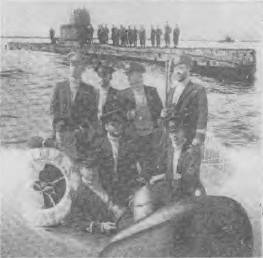- Author
- Jarrett, Hugh
- Subjects
- Ship histories and stories
- Tags
-
- RAN Ships
- HMAS Otway II
- Publication
- December 1996 edition of the Naval Historical Review (all rights reserved)
In December 1914, Lieutenant Douglas Norman Holbrook, RN, captain of a small old submarine, B11, penetrated the narrows in the Dardanelles and sank the Turkish cruiser, MESUDIYEH. This earned him a well-deserved Victoria Cross and the immortality of having a country town in New South Wales renamed in his honour.
The town, which lies 66 kilometres north of Albury on the Hume Highway had come to be named “Germantown” due to the fact that one of its early settlers was a German who became the local publican. Thirsty farmers went to the “German’s” and the locality acquired the name “Germantown”.
At the outbreak of war with Germany in 1914, feelings of the citizenry ran high against all things German and the name had to go. What better than to name it after the great VC? So it became ‘Holbrook’. Driving through Holbrook over the years, people with naval connections looked with approval at a large model of B11 which graced a town park, a visible link of a country town with the Navy – albeit the Royal Navy. When the Royal Australian Navy went back to operating submarines, the link with Holbrook became even stronger, evidence of which is the addition to the park of a bright and shining torpedo and the fact that the Submariners Association has made pilgrimages to the town for various celebrations. In spite of the fact that Holbrook is over 200 kilometres from the nearest sea it is quite clear that it is “Submarine Town, Australia”.

As I drove through Holbrook the other day, a most remarkable sight met the eye. I wondered – “Could it be? An Oberon-dass submarine out here?” Well – not entirely! But there she stood – the long black casing and tall thin sail of an Oberon dwarfing everything in town. Actually, it IS only the sail and casing, the parts of a submarine on the surface which are seen above water. It goes without saying that the bulk of the submarine – the pressure hull – would be impossible to transport. Even so, what you see is quite enormous and one realises that when you see such a vessel in service you cannot appreciate the full size of a submarine. The work of putting it all together does not seem, by any means complete, and various pieces of equipment, required or not required, lie around awaiting use or disposal. For example, hydroplane assemblies and torpedo tubes lie around adjacent to the main structure which stands in a large excavation.
As a Submarine Service memorial HMAS OTWAY is being set up for generations to come and see, wonder at and appreciate.
H.P. Jarrett,
Victorian Chapter
[MESSOUDIEH – spelling: It is generally agreed that the name of the battleship sunk by B-11 was “Mesudiye“. Ed:2016]




